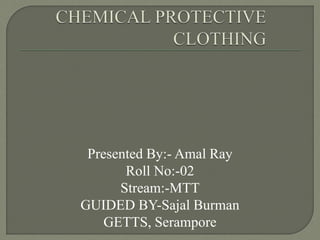
Chemical protective clothing (2)
- 1. Presented By:- Amal Ray Roll No:-02 Stream:-MTT GUIDED BY-Sajal Burman GETTS, Serampore
- 2. Protective clothing must be worn whenever the wearer faces potential hazards arising from chemical exposure. Some examples include : • Emergency response, • Chemical manufacturing and process industries, • Hazardous waste site clean up and disposal, • Asbestos removal and other particulate operations, • Agricultural application of pesticides.
- 3. Performance Requirements for Chemical Protective Clothing (CPC) •Chemical Resistance: •Durability •Flexibility •Temperature Resistance •Service Life •Cleanability •Design •Size •Color •Cost
- 4. Levels of Chemical Protection In Hazardous Material operations there are four levels of protection. •Level A •Level B •Level C •Level D
- 5. Level A Level A equipment consists of: •Positive-pressure, self-contained breathing apparatus (SCBA) •Gas-tight suit •Chemical-resistant inner and outer gloves •Chemical-resistant boots with steel toe and shank.
- 6. Level A Level A provides the highest level of skin and respiratory protection available. This type of protection must be gastight, vapor-tight and splash resistant. It is worn when there is a possible threat to life and health, such as during spill response and cleanup. Level A is used when: •Conditions are unknown •The hazardous substance has been identified and requires the highest level of protection for skin, eyes, and respiratory system •Operations are being conducted in confined, poorly ventilated areas •Work function involves a high potential for splash, immersion or exposure to unexpected skin hazards .
- 7. Level B Level B equipment consists of: •Positive-pressure SCBA •Chemical-resistant suit •Chemical-resistant inner and outer gloves •Chemical-resistant boots with steel toe and shank
- 8. LEVEL B Level B offers protection from chemical splash, but does not prevent exposure to gases or vapors. As with Level A, an SCBA is used for respiratory protection. The CPC may or may not be completely encapsulating, since a lower level of skin protection is required . Level B protection is used when: •Air contaminants are unknown •Air contaminants have been identified and the criteria for using APRs are not met •IDLH air concentrations exist •The atmosphere contains less than 19.5% oxygen •Direct contact does not pose a severe skin hazard
- 9. Level C Air-purifying respirator, chemical protective clothing, gloves, boots, and hard hat.
- 10. LEVEL C Level C features the same type of clothing as Level B, but has a lower level of respiratory protection. An air-purifying respirator is used in place of an SCBA . Level C protection is used when: •Criteria for the use of APRs (air-purifying respirators) are met •Air contaminants have been identified and concentrations measured •Direct contact does not pose a skin hazard
- 11. Level D Chemical-protective clothing, boots, gloves, and hard hat.
- 12. LEVEL D Level D offers the lowest level of protection and is used when no potential or actual hazard exists. It consists of a normal work uniform (long sleeve coveralls, safety shoes, goggles, etc.). Level D protection is worn when: •Atmosphere contains no known hazards •Work functions precludes the potential for unexpected exposure to hazardous levels of any substances
- 13. Penetration – defined as the bulk flow of a chemical through the protective material. Permeation – the diffusion of a chemical on a molecular basis through chemical protective clothing. Degradation – a change in the physical properties of the material as a result of adverse effects of the chemical.
- 14. Breakthrough Time – the time it takes the chemical to pass through the protective material until it is first detected by an analytical instrument. Permeation Rate – the mass flux (rate in mass per unit area per unit time) of the chemical through the protective material once it has broken through.
- 15. The National Fire Protection Association (NFPA) has devised performance manufacturing standards for CPC. NFPA 1991, Standard on Vapor-Protective Suits for Hazardous Chemical Emergencies covers gas-tight suits. NFPA 1992, Standard on Liquid Splash-Protective Suits for Hazardous Chemical Emergencies covers splash-protective garments. NFPA 1993, Standard on Support Function Protective Garments for Hazardous Chemical Operations covers splash-protective garments. NFPA developed these standards to provide users with information on suit integrity, resistance to chemicals and flame, durability and function of components. Garments that meet the NFPA requirements are approved and marked with a Safety Equipment Institute (SEI) label.
- 16. 1. Anderson, K. J., and J. G. Johnson (eds.), Chemical Protective Clothing, Vol. 1, American Industrial Hygiene Association, Akron, OH, 1990. 2. “Focus On Protective Clothing,” Applied Industrial Hygiene, 4 (1), January 1989, pp. R1–R5. 3. Forsberg, K.; and S. Z. Mansdorf, Quick Selection Guide To Chemical Protective Clothing, 1st. ed., Van Nostrand Reinhold, New York, 1989. 4. Roder, M. M., A Guide for Evaluating the Performance of Chemical Protective Clothing, National Institute for Occupational Safety and Health, Cincinnati, 1990. 5. Sabatino, J., “Dress For The Party (Selection Of Personal Protective Equipment),” Environmental Waste Management Magazine, 8 (6), June 1990, pp. 8–10.
- 17. THANK YOU